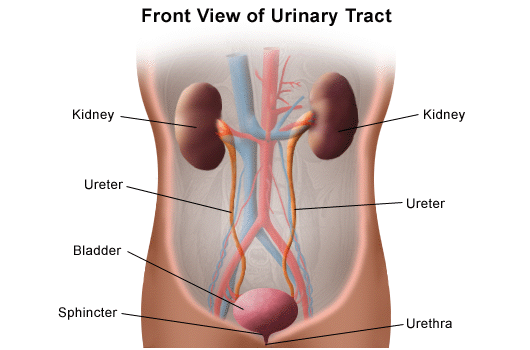Urinary Incontinence

Both men and women experience urinary incontinence — the leakage of urine. It may be a temporary condition, or it may result from an underlying medical problem.
For women — especially women over age 50 — the most common causes of urinary incontinence are:
- Overactive bladder. When the bladder contracts involuntarily when filling with urine, there is a sudden urge to urinate and sometimes leakage.
- Weakened pelvic floor and bladder neck. When the muscular base of the abdomen and the muscle band around the opening of the bladder are weak, urine can leak. It can range from the discomfort of slight losses of urine to severe, frequent wetting.
Male urinary incontinence affects approximately 13 percent of men. In men, the most common causes of urinary incontinence relate to:
- Treatment of prostate problems. Conditions like benign prostatic hyperplasia (BPH) and prostate cancer
- Overactive bladder (OAB). When the bladder contracts involuntarily when filling with urine, causing a sudden urge to urinate and sometimes leakage
- Urethral sphincter injury. Injury to the muscles that control the exit of urine resulting from surgery for a prostate disorder
- Underlying neurologic disease. Disorders like MS or Parkinson’s may affect sphincter function
Prevention
Although your risk for incontinence increases with age, it is not inevitable. It often occurs when muscles are either too weak or too active. If the muscles are weak, patients may leak urine when coughing or sneezing puts pressure on the abdomen. If muscles become too active, there may be a strong urge to go to the bathroom. Simple exercises can keep muscles in better working condition. In addition, your doctor or nutritionist can design a diet for you that supports urinary tract health. It helps to:
- Maintain a healthy weight. Remain active with a healthy diet and exercise regimen.
- Practice pelvic floor exercises. Men and women can learn to isolate pelvic floor muscles and do daily pelvic muscle exercises to improve tone. For women, El Camino Hospital offers a Total Control fitness series for pelvic health.
- Avoid bladder irritants. Reduce your intake of caffeinated and carbonated beverages and alcohol. Certain acidic foods can also irritate your bladder.
- Stop smoking if you smoke.
- Eat more fiber. Fiber-filled foods can prevent constipation, which can interfere with urination.
Symptoms and Diagnosis
People experience urinary difficulties in different ways; however, these symptoms are the most common:
- Inability to urinate (urinary retention)
- Pain related to filling the bladder and/or pain related to urination without a proven bladder infection (pelvic pain)
- Progressive weakness of the urinary stream, sometimes accompanied by a feeling of incomplete bladder emptying
- An increased frequency of urination without a proven bladder infection (irritative symptoms)
- Needing to rush to the restroom and/or losing urine if you do not get to restroom in time (urgency, urge incontinence)
- Abnormal urination or changes in urination related to a brain, spinal cord or nerve condition or injury (neurogenic bladder)
- Leakage of urine caused by coughing, sneezing, laughing or exercise that prevents activities and causes embarrassment (stress incontinence)
- Leakage of urine that began and continued after surgery (sphincteric injury or incompetence)
- Frequent bladder infections
The symptoms of urinary incontinence may resemble other conditions or medical problems. It’s vital to consult your doctor for a complete physical examination focusing on the urinary and nervous systems, reproductive organs and urine samples. In many cases, patients will then be referred to a urologist, a doctor who specializes in diseases of the urinary tract.
Treatments for Women
Treatments for female urge incontinence include medicine, pelvic health physical therapy, behavioral modification and sacral nerve stimulation (adjusting the nerve signals that control urinary frequency).
Treatment for female stress incontinence and pelvic organ prolapse include:
- Burch colposuspension. At the point where it meets the bladder, the urethra is lifted, suspended and stabilized so the bladder can control the flow of urine.
- Urethral sling surgery. A graft under the mid-urethra prevents leakage from coughing or sneezing.
- Sacrocolpopexy. Laparoscopic, open or robotic-assisted surgery lifts the vaginal contents and repairs prolapse.
- Periurethral bulking agent injection. Injecting agents like collagen help to prevent leakage of urine.
Treatments for Men
In men, nonsurgical treatments of urinating difficulty related to BPH and OAB consist of herbal supplements, prescription medicine, pelvic health physical therapy and behavioral modification.
Advanced therapy and surgical treatments for the inability to urinate effectively include:
- Minimally invasive therapy. To lift and hold the prostate away from the urethra so urine can flow normally
- Sacral nerve stimulation. In the case of OAB, to adjust the nerve signals that control urinary frequency
- Laser therapy PVP and TUVP. Advanced surgical methods used to remove obstructive prostatic tissue so urine can flow easily again
- Urethral sling. To help tighten the urethra to prevent leakage, usually after prostate surgery
- Artificial sphincter. For patients with sphincteric injury or neurologic dysfunction, to help the urethra close